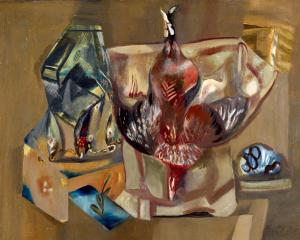John Bach has been trying to get under the skin of Mark Rothko, the controversial, argumentative New York artist who painted during the mid-20th century.
The Auckland-based actor is playing the role of the abstract expressionist in Red, a multiple Tony award-winning play by John Logan that opens at the Fortune Theatre on April 14.
"He was so intense. You lose the flavour of all the words you can use for him because he just becomes so concentrated," Bach says.
"The play is based around his passion not only to be relevant, but to go beyond just putting paint on canvas. He was always looking for something bigger, further. I think it's something beyond reach. It's like looking for God, in a way. What is God? Is there a God? No, there's no God, but I'm going to look for it anyway."
Rothko was a Russian Jew who had emigrated to the US with his family in 1913 when he was a child. Money was always tight and remained so until later in his life.
"One of his biggest fears was becoming a commodity. He fears people talking about owning 'a Rothko'. He rails against that but really, he's drawn towards it," Bach says.
The play covers two years in Rothko's life, 1958-1959. New York had become the centre of the Western art world and a huge creative impulse was happening in art, theatre, architecture, photography, dance, painting and music, with beat poets, hippies, abstract expressionists and then pop artists and others in the counterculture.
Rothko, an abstract expressionist, although he rejected the term, was a leading figure and accepted a prestigious commission to create a series of spectacular murals for The Four Seasons Restaurant in Manhattan's prestigious Seagram Building, designed by modernist architect Mies van der Rohe.
Rothko had told a friend: "I hope to ruin the appetite of every son of a bitch who ever eats in that room. If the restaurant would refuse to put up my murals, that would be the ultimate compliment. But they won't. People can stand anything these days."
He worked on the commission for a couple of years then decided to retain the 40 paintings and returned the $35,000 cash advance. While the reasons still remain mysterious, the play explores some of the issues and possible motives for Rothko's about-face.
Although Rothko had an assistant, Dan Rice, his fictional assistant in the play is a young artist, Ken, played by Cameron Douglas.
Rothko treats him as a kid who knows nothing, but he is trying to make his way as an artist too, Douglas says.
"Rothko never asks him about his work or anything so he's constantly battling with that, and there's a bit of resentment that goes on and comes out later in a big explosion," he says.
Director Lara Macgregor explains: "At the top of the play he is naive and eager. Rothko pushes him to question his theories, his philosophies, the way he looks at art, to dig deeper, to not just sit on the surface. Ken turns the tables later in the play, challenging Rothko about his philosophies. How can he sell out to a restaurant? They'd been talking about how everyone else had sold out."
Bach adds: "You are stuck with his arguments all the time, his damned arguments, and you have to intellectualise those to get past that. You've got to go through the intellect to get past the intellect so the other things can come out." Rothko believed you had to know everything - art, literature, music, mythology - if you wanted to be a painter. He got angry if people didn't understand or appreciate his art.
"He wanted certain things put together and if it wasn't going to be contemplated the way he wanted it, then no bugger was going to contemplate his art. It was a kind of bolshevism coming through," he says.
Rothko's paintings in this period were huge panels of soft-edged colours, but he always said he was painting the human form.
"God knows what that means. That's the problem with Rothko - how do you find out what he actually meant?", Bach agonises.
The paintings for the Seagram Building were red - but Bach is quick to riposte, "What is red?"
"There's very much a confrontation in there, where red appears. He was so didactic about so many things and when you ask the question and say red to Rothko, it's like the rag to the bull. What the hell is red? It encompasses too much. It encompasses so much you can't say red to Rothko. It's asking for trouble. And he's right - if you're on his side, and I'm on his side, I think he's right," Bach says.
But although Rothko was a leader in abstract expressionism, pop art was bursting on the scene with works such as Andy Warhol's Campbell's Soup Cans, as a reaction against the symbolism and intellectualism of abstract expressionism, and this was another demon Rothko had to deal with.
The play is set in Rothko's New York studio, where he is working on the murals. In one scene the two actors have to prime one of the large canvases. They make the primer on stage with eggs and other ingredients, according to Macgregor.
"The texture has to be right, and the speed it goes on to the canvas. Our theatre lights will dry the concoction faster so we have to make sure the recipe's right."
The designers, builders and stage managers are painting the Rothkos for the set, and have been assisted by Clive Humphreys, of the Otago Polytechnic School of Art.
See it
Red, by John Logan, directed by Lara Macgregor, opens at the Fortune Theatre on April 14.











